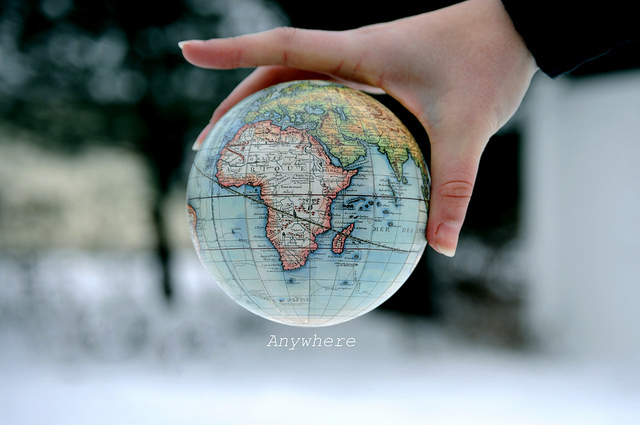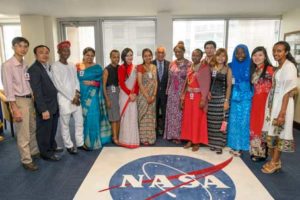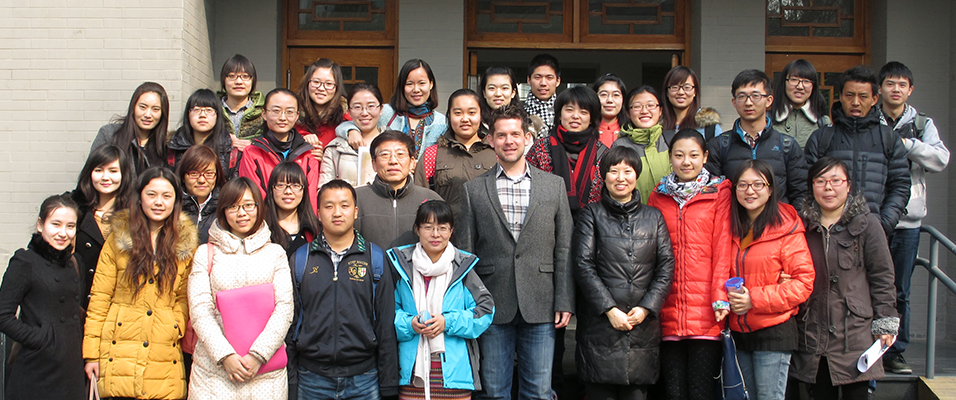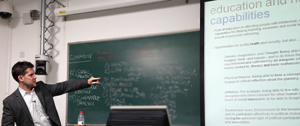East Lakes Division Team Takes 2014 World Geography Bowl

The East Lakes Team won first place in the 2014 World Geography Bowl, an annual quiz competition for teams of college-level geography students representing the AAG’s regional divisions. The event was its 21st year for hosting during its Annual Meeting.
On April 11, seven teams, each representing an AAG regional division, competed at the convention center in Tampa. Of the nine regional divisions, the following seven was represented by a team: East Lakes, Great-Plains Rocky Mountains, Middle Atlantic, Middle States, New England-St. Lawrence Valley, Pacific Coast, and Southeast Divisions, A spoiler team was added, comprised of students present at the competition.
At the conclusion of the exciting competition, AAG President Julie Winkler, wrapped up the event with an uplifting message and presented the winners with prizes. Bob Dulli (representing National Geographic Society) partnered with Julie Winkler to give out the Atlas prize to second runner-up winners.
The winning East Lakes Division team’s roster was:
- Steven Schultze (Team captain), Michigan State University
- Alex Colucci, Kent University
- Lisa Dershowitz, Miami (Ohio) University
- David Eichenauer, University of Toledo
- Michael Chohany, University of Toledo
- Evgeny Panchenko, University of Toledo
- Lisa DeChano-Cook (team sponsor/coach), Western Michigan University
The East Lakes team consisted of the top six scoring individuals from an on-line quiz that the region uses to determine the team each year. The team was coordinated by Dr. Lisa M. DeChano-Cook from Western Michigan University.
The first runner-up Middle Atlantic Division team’s roster was:
- Raynell Cooper (Team captain), George Washington University
- Owen Dowell, Salisbury University
- Sam Hudis, George Washington University
- Sara Hughes, Frostburg State University
- Walker Skeeter, Salisbury University
- Will Steckman, Frostburg State University
- Tracy Edwards (team sponsor/coach), Frostburg State University
The second runner-up Pacific Coast Division team’s roster was:
- Brendan Gordon (Team captain), University of Idaho
- Crystal English, San Diego State University / University of California, Santa Barbara
- Biniam Mengisteab, San Francisco State University
- Daniel Phillips, University of California, Santa Barbara
- Tina White (team sponsor/coach), Pasadena City College
The top five individuals with best personal scores were awarded an MVP prizes. Listed in order of most points earned:
- Raynell Cooper, George Washington University
- Brendan Gordon, University of Idaho
- Pete Akers, University of Georgia
- Kevin Bean, Bridgewater State University
- Evgeny Panchenko, University of Toledo
Thanks to 2014 WGB prize donors and volunteers
Organizers of the World Geography Bowl would like to express thanks to the countless volunteer question writers, team sponsors/coaches, moderators, judges, and scorekeepers who make the competition possible, and to the many students who competed throughout the country. We would like to recognize the volunteers this year as: Andrew Allen (University of Kansas), Casey Allen (University of Colorado Denver), Don Colley (San Diego State University), Jamison Conley (West Virginia University), Richard Deal (Edinboro University), Suzanne Dickens (Front Range Community College), Dawn Drake (Missouri Western University), Robert Edsall (Idaho State University), Emily Fekete (University of Kansas), Peggy Gripshover (Western Kentucky University), Melvin Arthur Johnson (University of Wisconsin – Manitowoc), Patrick May (Plymouth State University), Lee Nolan (Pennsylvania State University), Wesley Reisser (George Washington University and U.S. Department of State), Zia Salim (San Diego State University/University of California, Santa Barbara), Michael Webb (University of North Carolina).
World Geography Bowl organizers thank its supporters who generously donated atlases, books, gift certificates, softwares, and MVP awards – Avenza Systems, Cambridge University Press, East View Press, Esri, Guilford Publications, Lonely Planet, McGraw-Hill Higher Education, National Geographic Society, The University of Chicago Press, and The University of Georgia Press – who recognize the important role the competition plays in building a sense of community and generating excitement around geographic learning. Your continued support is truly appreciated.
And, a heart-felt thank you was expressed to Andrew Shears, assistant professor of geography at Mansfield University, for his three-year term leading the tournament. This was his final year as World Geography Bowl executive director. Jamison Conley (West Virginia University) succeeds Andy Shears as the new executive director.
2015 World Geography Bowl – Chicago
The 2015 World Geography Bowl competition will be held in Chicago in April, 2015. Regional competitions typically occur during the fall at respective AAG regional meetings, where regional teams for the national competition are usually formed. For more information on organizing a team, contact the World Geography Bowl executive director, Jamison Conley, at West Virginia University at [email protected] or Niem Huynh at [email protected] .
Note: This post has been edited to reflect the correct yearly anniversary. In a previous version it erroneously stated that this event hit the 25th year milestone.








